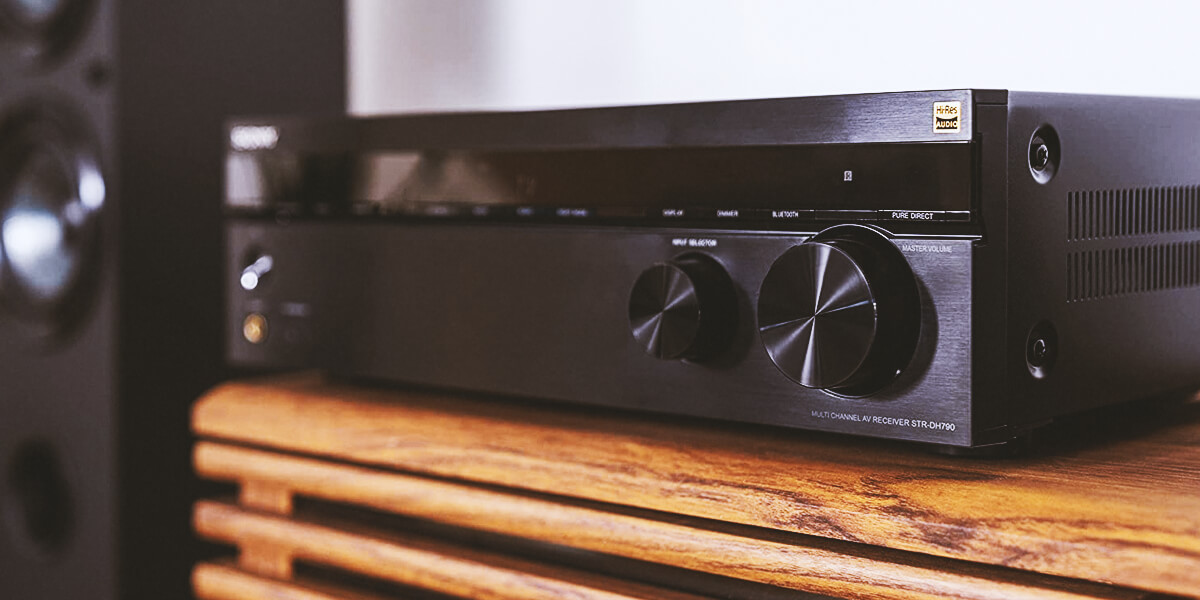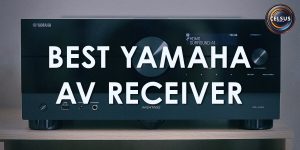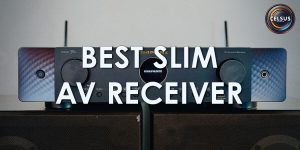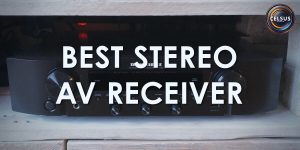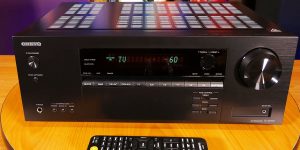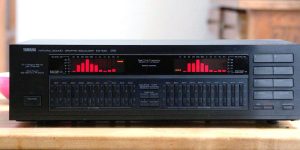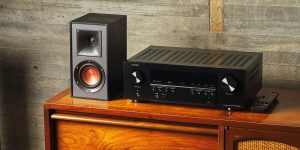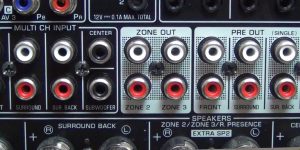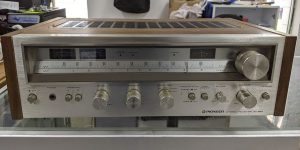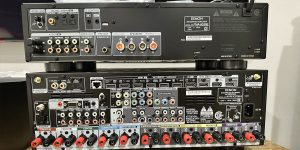A 7.1 receiver is a popular solution designed to provide immersive and high-quality audio experiences in your home theater. These receivers can power a 7-channel speaker system, delivering stunning surround sound with three front channels, two side channels, two rear channels, and a subwoofer. But the 7.2 configuration with two subwoofers is even more popular lately.
One of the significant advantages of the best 7-channel receivers is the ability to experience additional surround sound, which enhances the overall audio experience. With such a device, you can enjoy high-quality audio with crystal-clear dialogue, immersive sound effects, and powerful bass. Additionally, a 7-channel receiver is a minimum configuration that supports Dolby Atmos, allowing for a unique three-dimensional sound experience.
For this article, I have chosen the top 7.2 receivers available on the market, considering factors such as sound quality, features, and value for money. With my guide, you can choose the proper device that fits your needs and budget and enjoy a high-quality audio experience.
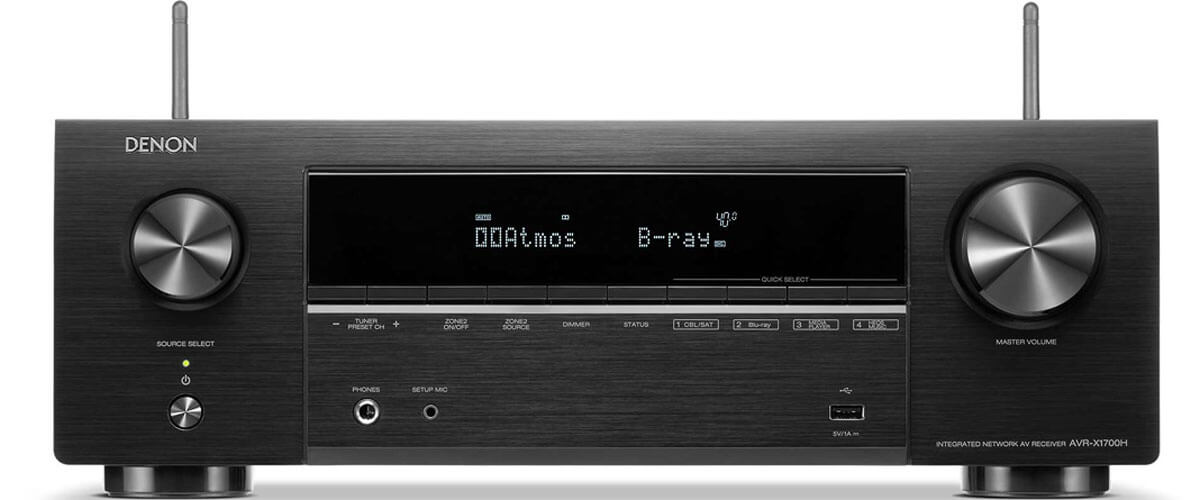
7.2 AV receiver comparison table
| Name | Channels | Power output | HDMI in/out | Bluetooth/Wi-Fi | Review |
|---|---|---|---|---|---|
| Denon AVR-X1700H best overall | 7.2 | 80W/8 Ohm, 120W/6 Ohm | 6/1 | yes/yes | Review |
| Sony STR-DH790 budget | 7.2 | 90W/6 Ohm | 4/1 | yes/no | Review |
| Yamaha RX-A2A also a great choice | 7.2 | 100W/8 Ohm | 7/1 | yes/yes | Review |
What is a 7.2 home theater system?
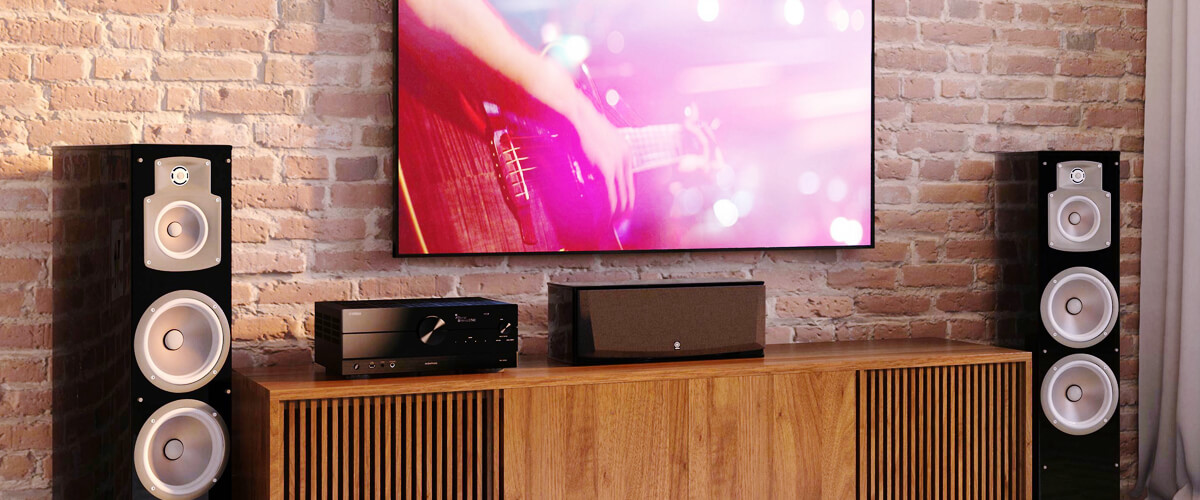
A 7.2 home theater system arrangement consists of seven speakers and two subwoofers. It will improve your overall viewing experience in that you can hear sound originating from different directions. Also, you may get higher audio quality because of the increased number of speakers located all over your room. This improves the sound distribution and reduces the overall pressure on every speaker. As a result, each of them produces a narrower range of sounds it can do better, giving a clearer immersive experience.
The 7.2 configurations can be quite expensive for all its benefits, especially if you’re using premium components. Installing such a system can also be quite complicated and take a lot of time. Because to achieve optimal sound quality, you need to place your speakers and subwoofers correctly. Of course, you cannot forget about your room’s acoustic parameters.
All things considered, a 7.2 home theater system is a good option for anybody seeking a premium audio experience. The advantages of genuine surround sound, improved audio quality, and Dolby Atmos compatibility makes it a worthy purchase, even if it can be pricey and difficult to set up.
How to choose a 7-channel receiver
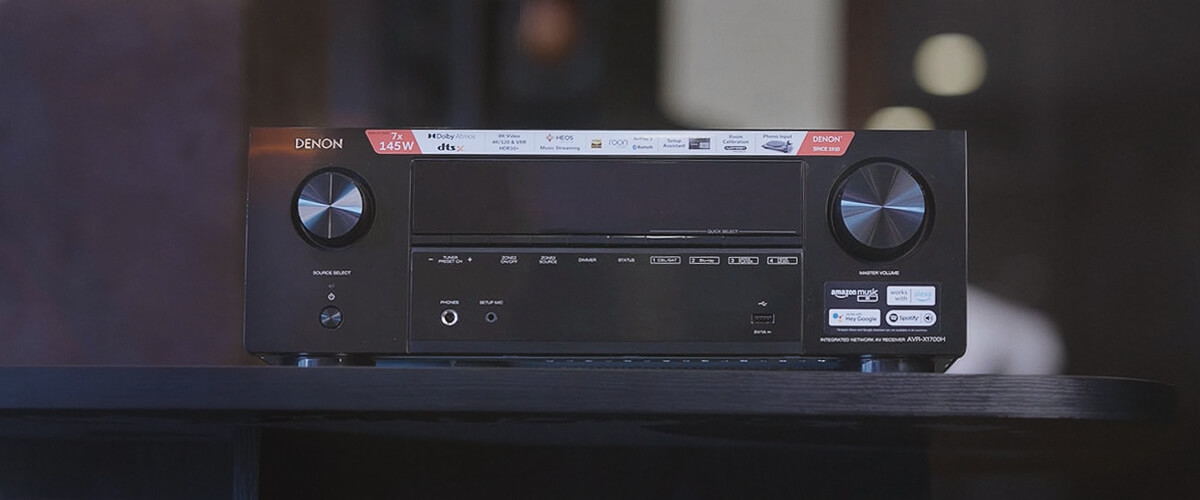
So, before we get to the review of receivers, let’s focus on the main points you should consider when choosing a model of this configuration.
How much power do you need
That’s a very slippery question. Why? Because power is actually not as important an indicator as it may seem at first glance. First of all, a heavy-duty receiver will not make you happy if it starts to “wheeze” at maximum volume and makes other not-quite-pleasant sounds. Secondly, you do not plan to constantly use your audio equipment at maximum volume. Thirdly, you need to evaluate several parameters together: the size of your room, the quality of the speakers, the power, and THD.
For 7-channel receivers, the optimum power is in the range of 75-100 watts. This is quite enough for a uniform sound filling of a room of about 300-400 square feet. A distortion factor of 1% or more for receivers is considered bad. For example, a receiver model with 75 watts (THD – 0.08%) can sound identical or even louder than a receiver with 100 watts (THD – 0.8%). And most importantly, the sound will definitely be “cleaner” at maximum RPM.
HDMI inputs and 4K/8K
Having multiple HDMI inputs is something you should pay close attention to. And here, the simple rule “the more, the better” works. After all, the receiver is a device that should provide communication with other components of your multimedia system. Therefore, analyze what equipment you already have and what you are planning to buy and, based on this, determine the necessary minimum of connectors that the receiver should have.
Pay attention only to HDMI version 2.1 ports, as they have the latest functionality (eARC, HDCP 2.3, CEC, and advanced features for gamers), and you won’t need to upgrade your receiver for a long time.
Another important aspect is the receiver’s support for 4K/8K video resolutions and the ability to upscale to these quality levels. Yes, there isn’t much 8K video content out there yet, but you have to think ahead. Also, technologies like Dolby Vision, HDR, HDR10, and HDR10+ can seriously improve picture quality. Many 7K models usually support some of these. It’s worth checking your TV to see if it can handle these technologies and screen resolutions.
Dolby Atmos and DTS:X
Yes, surround sound is the highest priority among other AV receiver features. Surely, you want to watch the world’s blockbusters with incredible sound. So what to look out for?
In addition to working with the basic 3-D sound formats, many modern 7-channel receivers support the now very popular Dolby Atmos and DTS:X. Indeed, these technologies provide a deeper immersion in the soundstage and configure the effect of a real movie theater when the sound surrounds you from all sides.
But you should realize that a 7.2 configuration (or 5.2.2 for Dolby Atmos) cannot fully utilize the full capabilities of Dolby Atmos and DTS:X. That’s why I recommend you pay attention to receiver models that support their virtual versions (Dolby Atmos Height Virtualizer and DTS Virtual:X).
Multi-room audio and wireless connection
Typically, 7-channel receivers have more wireless connectivity options than their 5-channel counterparts. They are equipped with built-in Wi-Fi and Bluetooth. In addition, many modern devices provide support for DTS Play-Fi, AirPlay 2, and Chromecast, as well as can work with aptX, SBC, or AAC codecs for Bluetooth 4.2. Such capabilities positively impact the overall quality of lossless signal transmission in high quality.
The availability of advanced wireless capabilities allows you to build audio systems for multi-room broadcasting. You can turn your home or apartment into unique audio zones with HEOS (Denon, Marantz), MusicCast (Yamaha), and Sonos multi-room technologies.
How much do 7.2 AV receivers cost
The price depends on a number of parameters, such as the manufacturer, the capabilities of the device, and the availability of additional features. But on average, the price for 7-channel AV receivers ranges from 450 to 1500 dollars. So expect that for 1000$ you will be able to buy quite a decent 7-channel receiver.
Best 7.1 receiver reviews
Denon AVR-X1700H – best overall

Home theater receiver Denon AVR-X1700H was initially made available in 2019. This model is a member of the X-series from Denon. Denon promotes the AVR-X1700H as a mid-range receiver that aims to provide an economical yet high-performance solution for those wishing to enhance their home entertainment setups.
The Denon AVR-X1700H has a conventional appearance. A simple and easy-to-read LCD screen, a volume knob, and a few control buttons make up the front panel. The receiver is 6.6 x 17.1 x 13.3 inches in dimension and weighs 19.0 lbs. It is small and will readily fit into every interior. The receiver has a solid chassis and seems well-made and long-lasting.
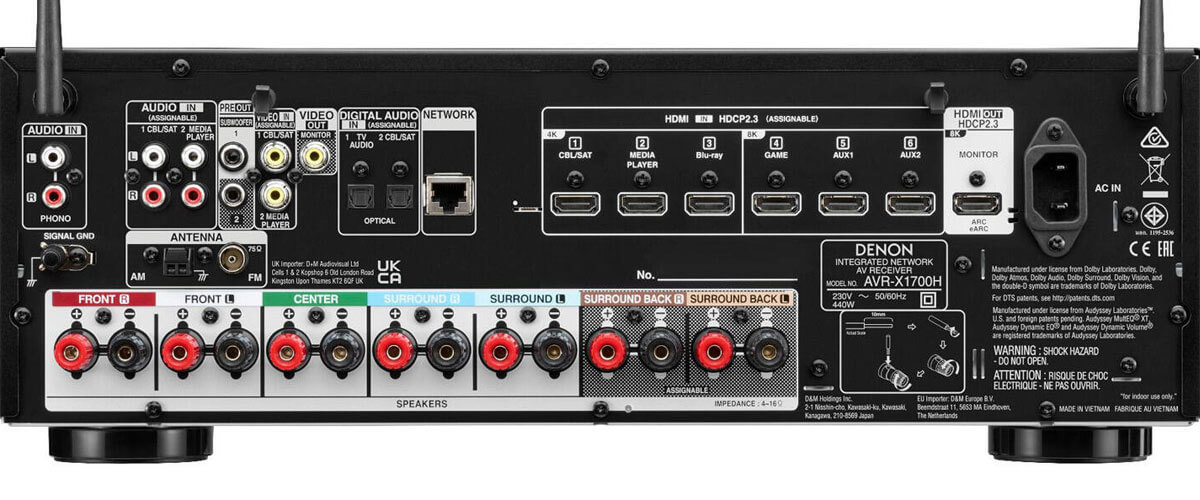
The unit delivers 80 watts of power per channel at 8 ohms and 20 Hz–20 kHz a 0.08% THD 2-channel driven, which is a pretty decent amount concerning the THD. However, the power output is much higher with 6-ohm impedance speakers: 175 watts per channel at 6 ohms, 1 kHz, and 10% 1-channel drive, compared to 120 watts per channel at 1 kHz and 0.7% 2-channel drive. So, is it sufficient to rank it among the best 7.2 receivers? Let’s examine its characteristics in more detail.
The AVR-X1700H has a broad amount of connectors on the back panel, including six HDMI inputs and one HDMI output, as is customary for receivers. HDCP2.3 is supported by all HDMI ports, 3 of which can handle 8K video. It also has several analog and digital audio inputs, a single composite output, and radio antennae. Moreover, it supports HEOS Multiroom and streaming services and includes a USB port. The unit also supports Bluetooth and Wi-Fi.
DTS HD Master, DTS:X, Dolby TrueHD, and Dolby Atmos are the main multichannel surround sound formats with which the Denon AVR-X1700H is compatible.
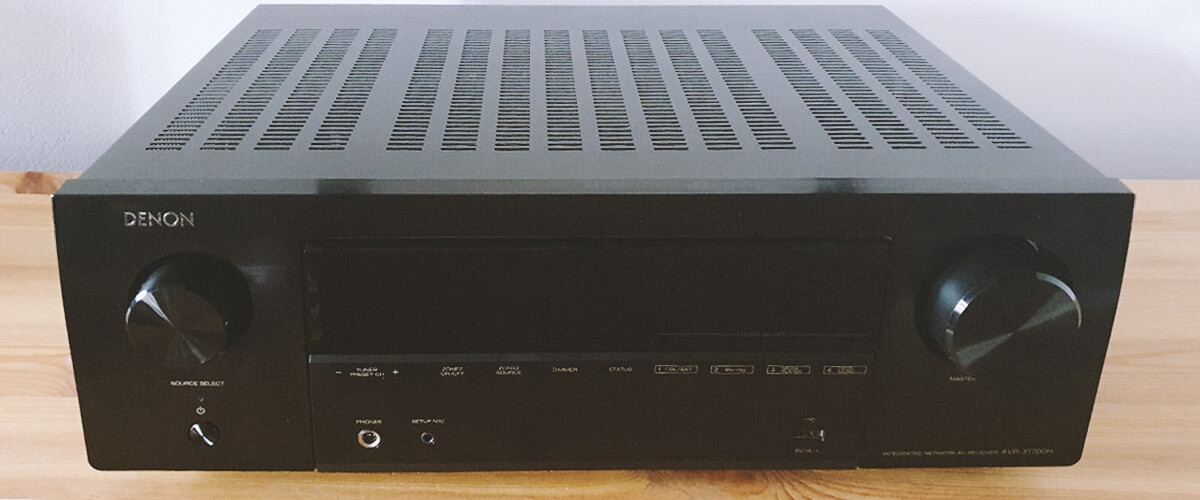
Considering video features, the Denon AVR-X1700H supports up to 8K 60/50 HDMI to HDMI scaling. In addition, it contains HDMI capabilities, including CEC, eARC, and 8K/4K pass-through. Moreover, it supports HLG, HDR 10+, Dynamic HDR, and Dolby Vision, HDMI capabilities, including ALLM, QMS, QFT, and VRR. It can also transmit HDMI signals in standby mode.
In music, the unit offered a full spectrum of immersive sound. It performed admirably when I tested it across various genres, picking up even the minute details in every recording. I also can’t help but notice the music’s outstanding quality. Overall, you wouldn’t anticipate such results from AV receivers. This device came quite close to matching the performance of stereo receivers.
The Denon AVR-X1700H put me in the heart of the action during movie playback with its clear, distinct sound and immersive audio. It also has a remarkable capacity to handle complicated sounds, for example, when speech, effects, background music, and other sounds are combined in a movie. When this happens, the receiver makes it possible to hear each sound!
The Denon AVR-X1700H performed really well in my tests. Its capacity to produce powerful and detailed sound pleasantly surprised me, especially when compared to the Yamaha RX-V6A, which is infamous for its issues with clarity and accuracy. Based on my testing, I believe the Denon AVR-X1700H to be a top performer for music and video playing, offering incredible value for the money. The AVR-X1700H is, without a doubt, the best 7.2 AV receiver currently on the market in its price segment and the leader of my top!
Key specs
- Channels: 7.2.
- Power output: 80W/8 Ohm, 120W/6 Ohm.
- HDMI inputs/outputs: 6/1.
- Video functions: 8K/60Hz, 4K/60Hz, 4K/120Hz, HDMI upscaling up to 8K.
- Bluetooth/Wi-Fi: yes/yes.
- Streaming services: AirPlay 2, Spotify, TuneIn, Deezer, Tidal, Netflix, Amazon Prime.
- Supports: HDMI ARC, HDMI eARC, HDMI CEC, HDCP2.3, HDR10+, Dolby Vision.
- Surround sound: DTS HD Master, DTS:X, DTS Neural:X, DTS Virtual:X, Dolby Atmos, Dolby TrueHD, Dolby Height Virtualization, Dolby Surround.
Pros
- Rich set of features.
- 3 HDMI ports with support of 8K.
- Balanced performance in movies and music.
Cons
- Lacks HDMI inputs on the front.
- Outdated remote and interface.
Sony STR-DH790 – budget
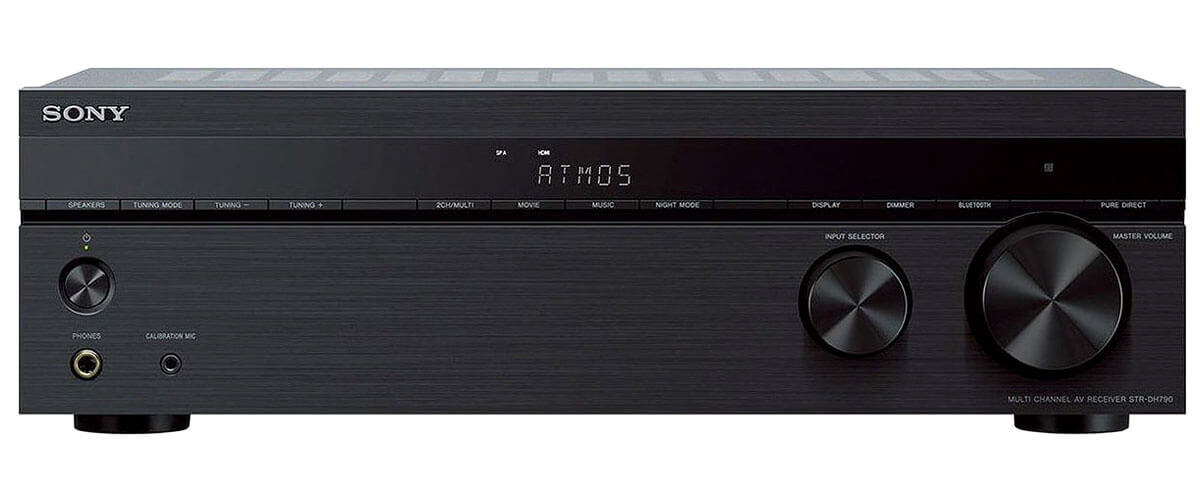
The Sony STR-DH790 is a 7.2-channel home theater AV receiver released in 2018. Sony positions this model as a versatile and affordable option for people who want to join the world of high-end audio. The device is part of Sony’s entry series of AV receivers, which includes models designed to balance affordability and a rich set of technologies. The STR-DH790 is a successor to the popular STR-DH770 model and offers several upgrades over it.
Without a single doubt, Sony always aspirated to bring new notes into the niche of AV receivers. The STR-DH790 offers to a certain extent unusual design for the receiver. It has a compact size, measuring 17″ x 5-1/4″ x 11-3/4″, and a weight of 16 lb 6 oz. The front panel is elegant, featuring large display and control surfaces shifted to the side. Thus, this model looks non-standard, stylish, and, most importantly, practical.
The Sony STR-DH790 supports from 6 up to 16 ohms speakers. Additionally, the device can serve as a 5.1.2 receiver with separate decidable channels and 7 channel output of 145W per single one (6 ohms, 1kHz, 1ch THD 0.9%). The power with 8 ohms speakers is going to be a bit lower. The manufacturer guarantees the sound quality both with 6 and 8 ohms speakers. The unit features various sound fields, including 2ch Stereo, Direct, Multi Ch Stereo, Dolby Surround, Neural: X, Front Surround, Audio Enhancer, and Headphone 2ch.
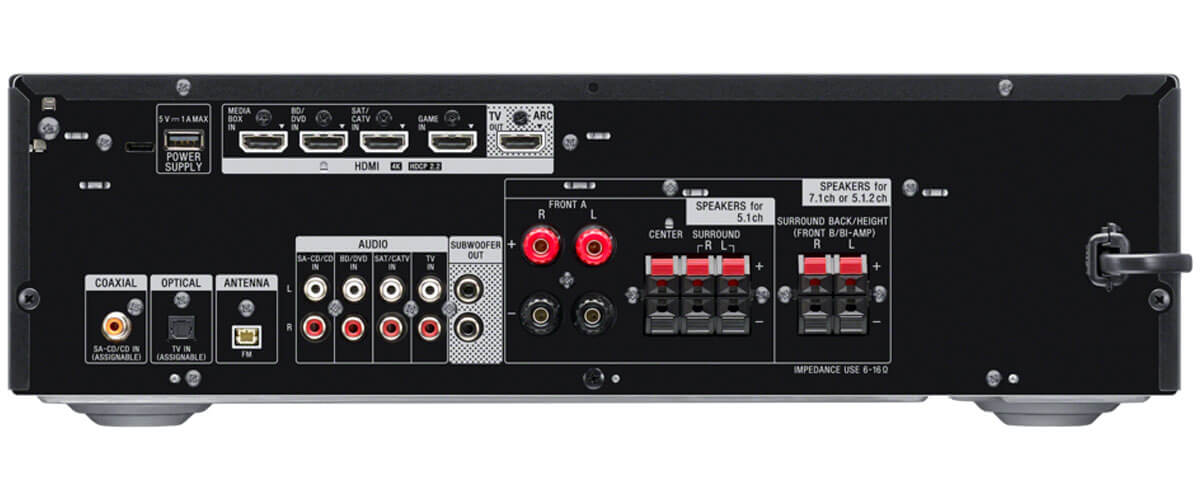
The interface offers 4 HDMI inputs with HDCP 2.2 support, a single HDMI output, and audio input options for optical, coaxial, and analog connectors. The amplifier also features a pre-out subwoofer, headphone output, and a USB connector. It also features Bluetooth connectivity but lacks Wi-Fi.
Talking about video features, those include the ability to transmit 3D signals over HDMI and 4K 60p 4:4:4. The device also has A/V SYNC. Additionally, the Sony STR-DH790 supports ARC and eARC. The device also features BRAVIA SYNC helping to use a single remote. Finally, this unit offers HDR technology, including HDR10, HLG, and Dolby Vision compatibility. Yet, it doesn’t come with HDR10+.
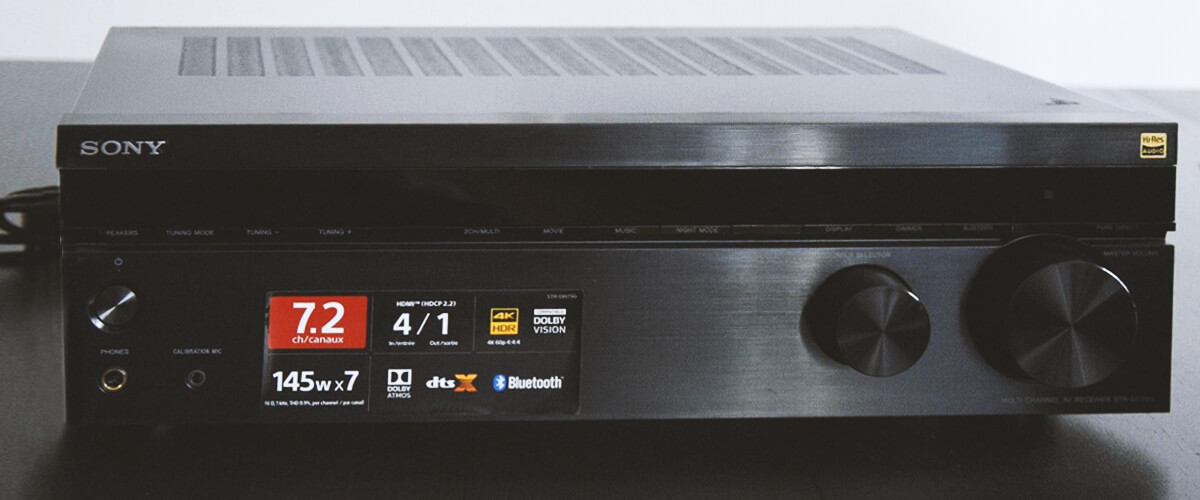
The STR-DH790 does not graze the rear with its audio features, as it has the latest audio codecs, including Dolby Atmos and DTS:X. Additionally, the STR-DH790 offers the following lossless codecs FLAC, ALAC, and DSD files. I also enjoyed Sony’s proprietary S-Force PRO front surround sound technology. Surely, it’s far from an honest 5.1 or 7.2 setup, but even with two speakers, it can still deliver a miracle of surround-like sound.
When testing the STR-DH790, I notice stunning clarity and accuracy in reproducing audio. Action movies, emotional romantic comedies, noisy older movies – all sounded well and greatly balanced with a defined sound stage. Bass sections were another miracle I enjoyed – free from distortion, and punchy lows are what one needs to enjoy a movie. The unit also showed itself capable with music. Due to its supreme power, it didn’t max out even a single time. Also, multiple sound adjustment features allowed me to make the music sound exactly as I love without making it seem unnatural.
Overall, the Sony STR-DH790 is an impressive 7.2-channel home theater AV receiver that offers an excellent balance between affordability and advanced features. It has an interesting design, featuring a compact size and weight while still being fully packed with capabilities. This model boasts numerous sound fields and supports various audio codecs making it the best budget 7.2 home theater receiver.
Key specs
- Channels: 7.2.
- Power output: 90W/6 Ohm.
- HDMI inputs/outputs: 4/1.
- Video functions: 4K/60Hz pass-through.
- Bluetooth/Wi-Fi: yes/no.
- Streaming services: no.
- Suppots: HDMI ARC, HDMI eARC, HDMI CEC, HDCP2.2, HLG, HDR10, Dolby Vision.
- Surround sound: DTS HD Master, DTS:X, DSD, Dolby Dual Mono, Dolby Atmos, Dolby Digital Plus, Dolby TrueHD.
Pros
- A versatile and affordable option for people who want to join the world of high-end audio.
- Can work with speaker impedance from 6 up to 16 ohms.
- Can function as a 5.1.2 receiver with separate decidable channels.
- Supports latest audio codecs, including Dolby Atmos and DTS:X.
- Stunning clarity and accuracy in reproducing audio.
Cons
- No support for HDR10+.
- Power output is slightly lower with 8-ohm speakers.
- May not be suitable for larger rooms due to its power output.
- The device doesn’t come with built-in Wi-Fi.
Yamaha RX-A2A – also great
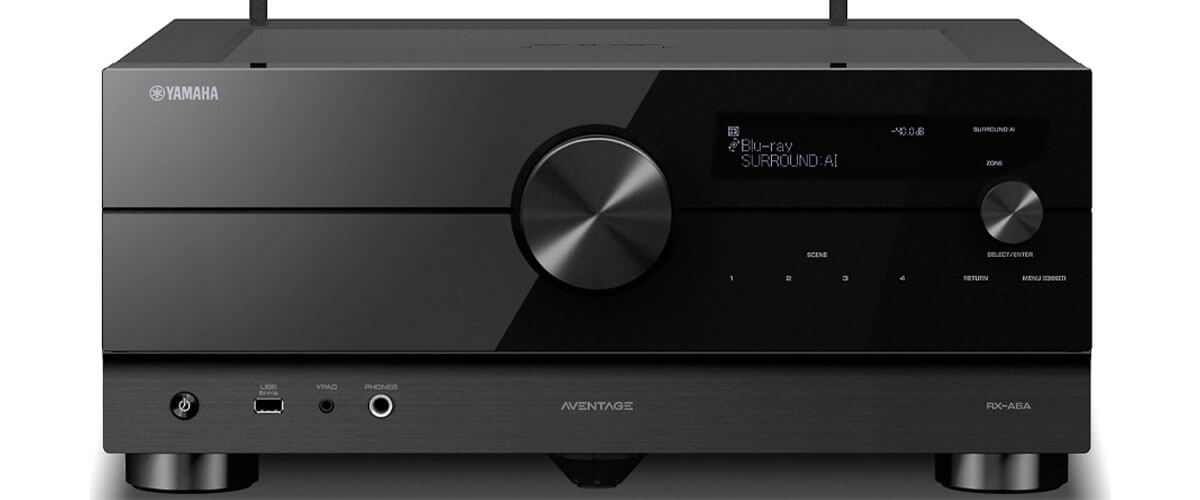
The Yamaha RX-A2A is a 7.2-channel AV receiver that was released in 2020. The company positions the RX-A2A as part of its AVENTAGE series of AV receivers. The line itself is famous for quality units. The RX-A2A is the successor to the popular RX-A680 model and offers several upgrades over it, including advanced technologies. So, here I uncover the truth about Yamaha RX-A2A and compare it to some of its main competitors.
The receiver comes with a typical Yamaha design, with a large control knob right in the middle, a display shifted to the side, and a smaller control surface located even further left. As for me, the other side looks somewhat empty. Yamaha uses quality materials to build every device – the RX-A2A is no exception. It has a relatively compact size, measuring 17-1/8″ x 6-3/4″ x 14-7/8″ and weighing in at 22.5 pounds. Overall, the look of this model is pretty disputable, and it is also pretty average in size and weight.
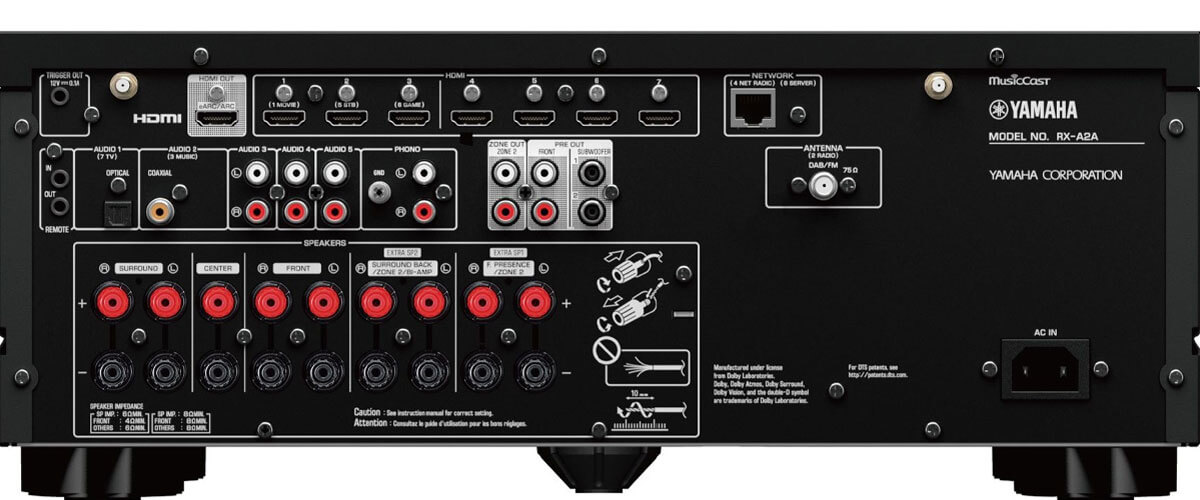
The Yamaha RX-A2A offers 100W with 8 ohms speakers, 0.06% THD per channel. It doesn’t hold a power record but is sufficient for small to medium rooms. The built-in DAC module is 384 kHz / 32-bit BB PCM5102A. This chip is famous for accuracy and fidelity. Theoretically, this should mean that the RX-A2A is a universal unit for all tasks, but is it?
The unit comes with rich connectivity, featuring 7 HDMI, a sole HDMI output, USB, digital audio inputs such as optical and coaxial, and 4 analog audio inputs. The device also has a headphone output and an AM/FM tuner. In addition, the MusicCast app allows you to control the unit from a smartphone.
Switching to audio technologies, the RX-A2A supports a wide range of Dolby technologies, as well as Wi-Fi and AirPlay 2. The unit can be controlled via Alexa and others. Additionally, the RX-A2A offers access to popular music streaming services such as Spotify and others.
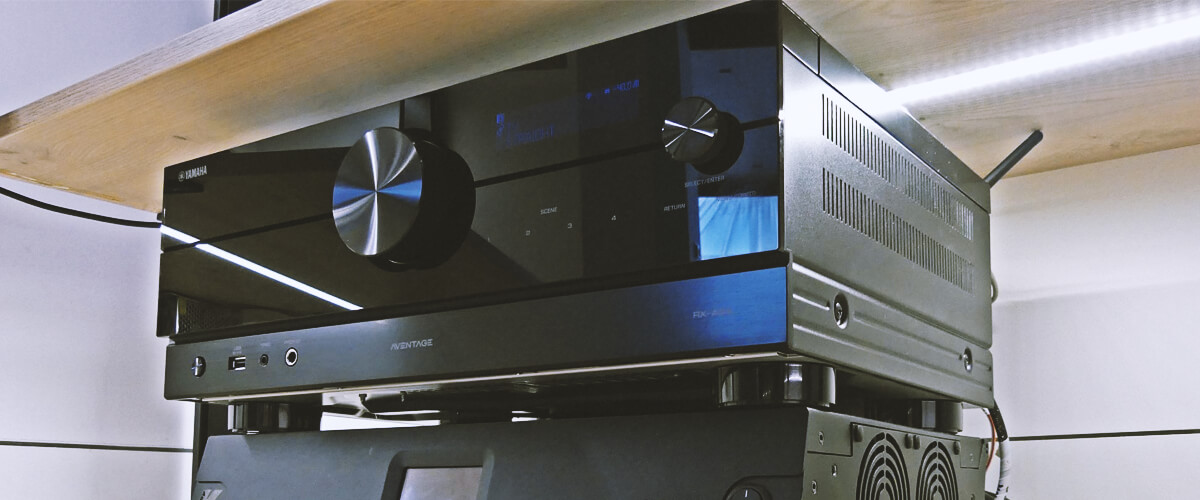
Yamaha also paid a decent effort to the video features of the RX-A2A. Those include 4K/60, Dolby Vision, Hybrid-Log Gamma, and BT.2020. It also features 4K/120AB, 8K/60B HDMI, HDR10+ with HDCP 2.3 and eARC. Additionally, the RX-A2A supports ALLM and VRR. I had no issues with smoothness and frame tearing both in movies and games.
The unit delivered rich and dynamic sound in movie soundtracks during my tests. It was clean and precise enough that I could feel every detail. The sound lacked some tones the AVR-X1700H delivered, but it still was pretty impressive. I also experienced the same level of detail in music, especially with lossless codes.
In conclusion, although the Yamaha RX-A2A would benefit from more power, it is just sufficient enough for small and even medium places. The unit is a reliable and versatile AV receiver suitable for movie enthusiasts and music lovers. This makes it a great 7.2 surround sound receiver worthy of money and time.
Key specs
- Channels: 7.2.
- Power output: 100W/8 Ohm.
- HDMI inputs/outputs: 7/1.
- Video functions: 8K/60Hz, 4K/60Hz, 4K/120Hz, HDMI upscaling up to 4K.
- Bluetooth/Wi-Fi: yes/yes.
- Streaming services: AirPlay 2, Spotify, TuneIn, Deezer, Tidal, Netflix, Amazon Prime.
- Supports: HDMI ARC, HDMI eARC, HDMI CEC, HDCP2.3, HDR10+, Dolby Vision.
- Surround sound: DTS HD Master, DTS:X, Dolby Atmos, Dolby Atmos Height Virtualization, Dolby TrueHD, Dolby Digital Plus, Dolby Surround.
Pros
- Rich connectivity options.
- The rich set of supported technologies does not disappoint.
- Universal use with immersive sound.
Cons
- The design is somewhat disputable and not very visually appealing.
- 100W way won’t be enough for larger rooms.
- Average in terms of size and weight, lacking the bulk that some users may prefer in higher-end receivers.
Onkyo TX-SR494
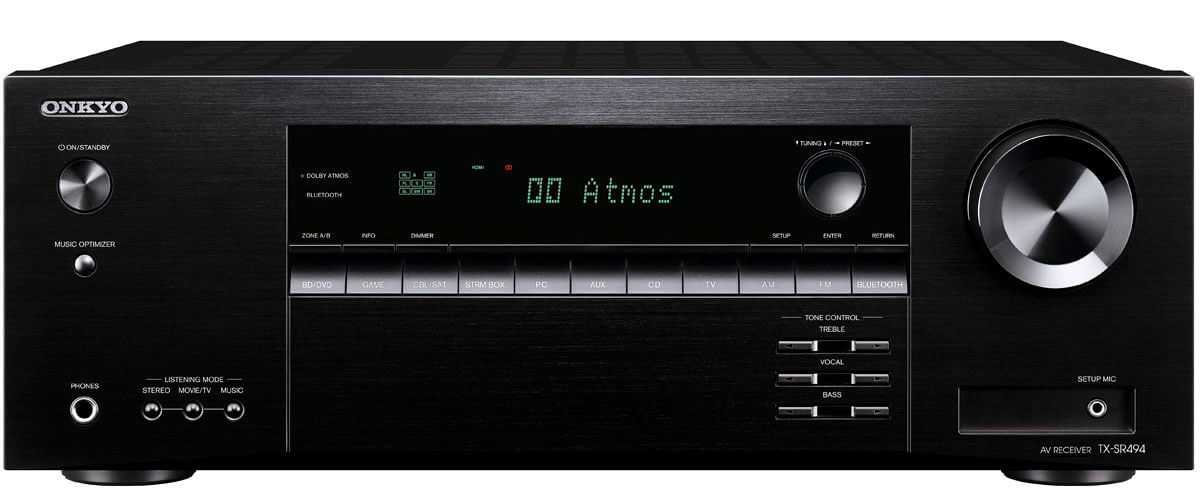
The Onkyo brand is well-known for creating high-quality audio products, including AV receivers that fit a variety of purposes and price points. The Onkyo TX-SR494 is a mid-range, 7.2-channel AV receiver with some features that make it a favorite among home theater fans.
The TX-SR494 is a slim, traditional-looking AV receiver with a classic appearance. It sports a glossy display panel, a huge volume knob in the middle, and a matte black exterior. Additional control buttons on the front panel provide rapid access to frequently used features, including input selection and sound options. Despite its affordable pricing, the TX-SR494 doesn’t skimp on materials and construction quality, making it a dependable and durable addition to any home entertainment system.
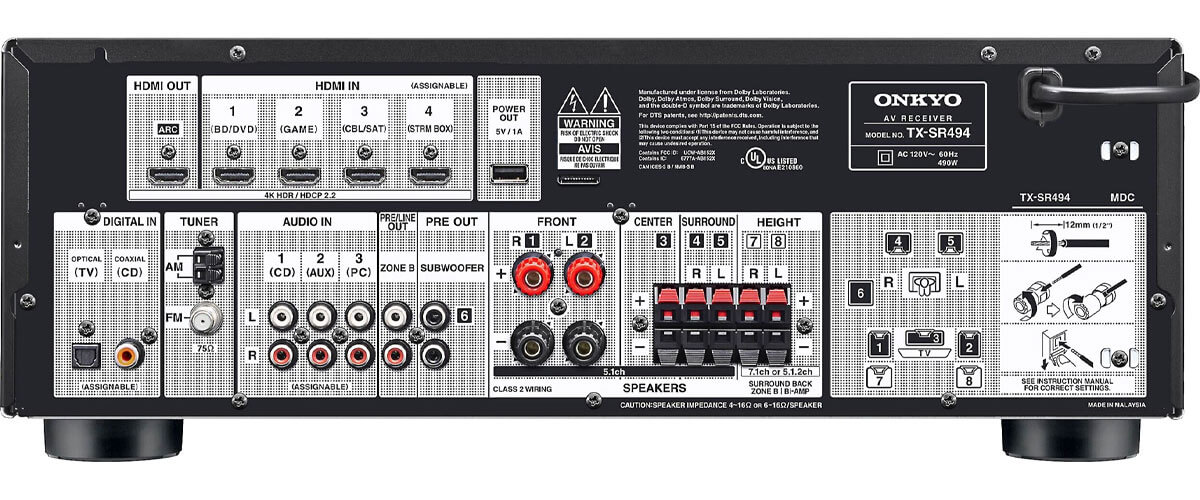
The unit delivers a maximum power of 80 watts per channel at 8 ohms with 0.08% THD with 2 channels. However, when a single one with a 6 ohms speaker and 1kHz, the power output increases to 160 watts. At the same time, THD also increases to 10%. The receiver is also certified for 4 ohms performance, featuring 384K/32 Bit DAC. In addition, the TX-SR494 has discrete output stage circuitry and bi-amp capability for front speakers for two additional amplifiers.
The device has three analog audio inputs, one optical and one coaxial digital audio input, one USB input, four HDMI inputs, and a single HDMI output with 4K pass-through. Additionally, it has dual subwoofer analog pre-outs and supports Bluetooth connectivity and AM/FM radio. Clearly, the unit would benefit from having more HDMI inputs, especially considering its price.
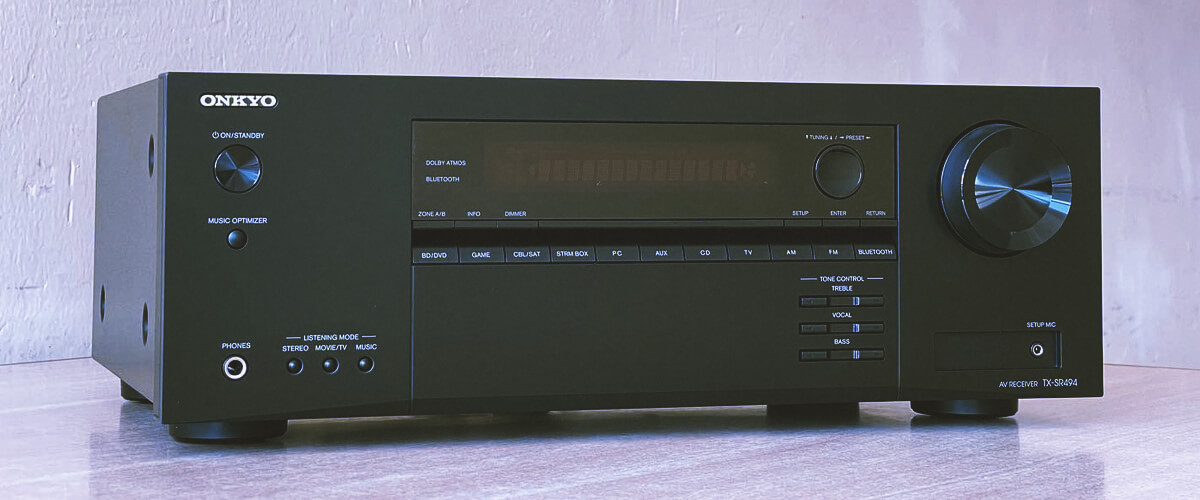
The Onkyo TX-SR494 offers a rich set of features and formats, including DTS:X and the Dolby family of technologies. The 32-Bit signal processing unit stands for the quality of distortion-free sound. Overall, the unit is very well-packed with video and audio technologies. At some point, I even felt it would be today’s champion.
Before my tests, I felt pretty encouraged. After all, the unit supports a whole bunch of various technologies, common for more expensive models. At the same time, in my tests, it showed itself to be less impressive but still delivered quality. First of all, I enjoyed the light crispness of sound in movies. Combined with a clean special effect, this crisp sound adds points to the atmosphere.
On the other hand, in music, it truly felt that the unit should avoid pumping so much bass because it felt overwhelming. So yes, I managed to adjust it via built-in modes. Still, this shouldn’t be the case, especially when discussing an out-of-the-box solution.
Overall, the Onkyo TX-SR494 is a reliable and durable AV receiver with plenty of features that make it a good choice. However, it may not be an option for music enthusiasts as it lacks certain features, is not optimized enough for this, and has fewer connectivity options than other models. Yet, lovers of typical Onkyo sound definitely won’t be disappointed with the performance of this unit.
Key specs
- Channels: 7.2.
- Power output: 80W/8 Ohm, 160W/6 Ohm.
- HDMI inputs/outputs: 4/1.
- Video functions: 4K/60Hz pass-through.
- Bluetooth/Wi-Fi: yes/no.
- Streaming services: no.
- Suppots: HDMI ARC, HDMI CEC, HDCP2.3, HDR10.
- Surround sound: DTS HD Master, DTS:X, DTS Neural:X, DTS Virtual:X, Dolby TrueHD, Dolby Atmos, Dolby Digital Plus, Dolby Atmos Height Virtualization, Dolby Surround.
Pros
- Exceptional build quality.
- Supports a video range of formats, including DTS:X and the Dolby family tech tree.
- Overall well-packed with video and audio technologies.
Cons
- The unit has only four HDMI inputs.
- Problems with bass—sometimes it is too overwhelming.
Pioneer Elite VSX-LX105
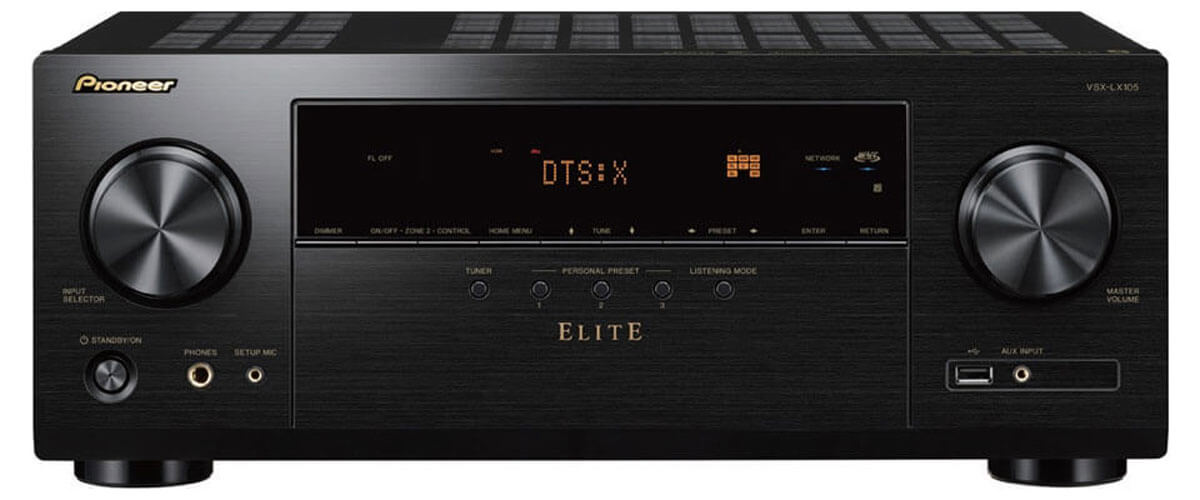
Last but not least comes Pioneer Elite VSX-LX105. This 7.2-channel unit came to market as the company’s attempt to deliver a powerful and immersive sound to new customers at a fair price. Pioneer has its name for creating high-quality products, so the Elite VSX-LX105 was an obvious choice for this review.
The Pioneer Elite VSX-LX105 is a well-designed device with a solid chassis and a quality look and feel. Even despite its outdated design layout, the unit still looks stunning. The face of the unit features a convenient display screen, a volume dial, and many control buttons for convenient access to the receiver’s capabilities. The chassis is composed of high-quality materials, making it sturdy and assisting in heat dissipation. Talking about sizes WHD: 17-1/8 x 6-13/16 x 14-9/16 inches, and weight is 21.6 lbs.
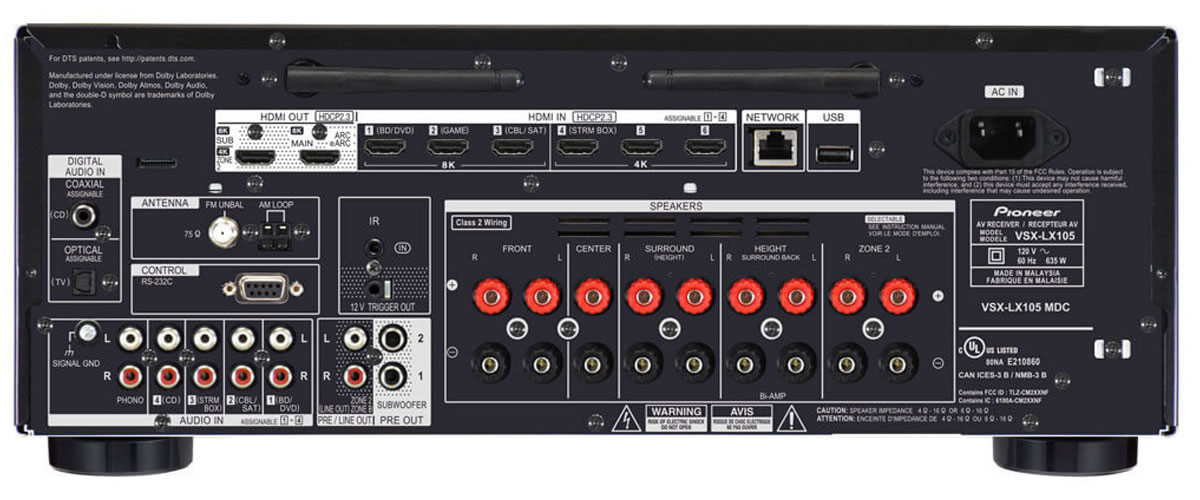
The Pioneer Elite VSX-LX105 AV receiver can drive as much as 100 watts per channel (with 8 ohms speakers, 20 Hz-20 kHz, THD 0.08%, 2ch Driven FTC) and 210 watts per channel (with 6 ohms ones, 1 kHz, THD 10%, 1ch Driven). The DAC chip is 192 kHz/24-bit D/A. The unit comes with numerous features, including Dolby Atmos, DTS:X, and others. It also has several Advanced Surround Modes, allowing you to adjust them.
The Pioneer Elite VSX-LX105 offers six HDMI 2.1 inputs and 2 outputs (one for the main display and one for a sub/zone 2). They can work with 8K/60p and 4K/120p content. The receiver also has a USB input, an MCACC setup MIC input, an Ethernet, phono, and digital coaxial and optical ones. It also offers gold-plated audio, a headphone jack, and a subwoofer. Additionally, the unit has FM/AM antenna inputs.
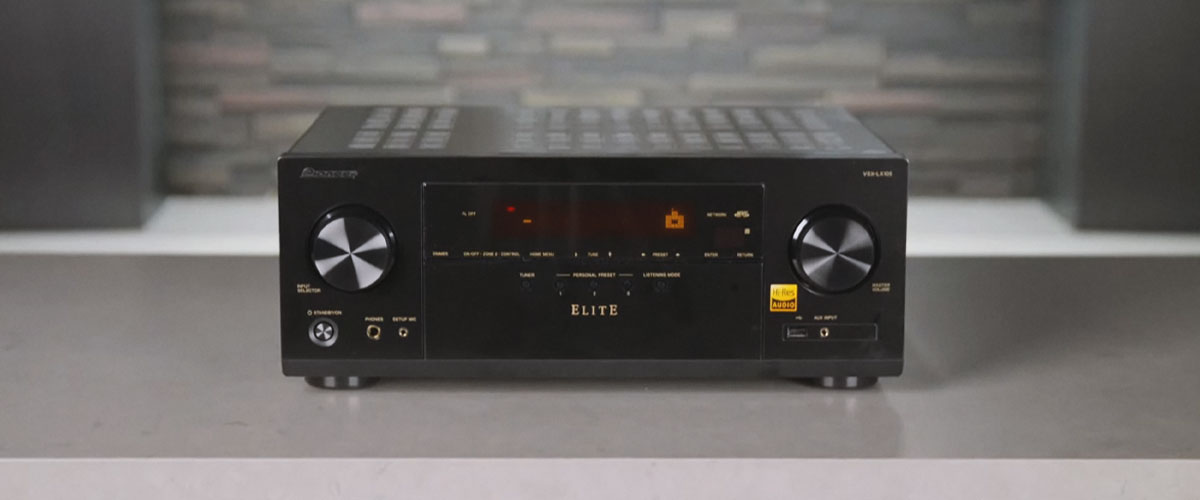
The model supports HDMI 2.1 with 8K resolution, VRR, ALLM, QFT, and DSC. It also supports HDR10+ and HLG. The device can display 8K/60p, 8K/30p, 4K/120p, 4K60p, and BT.2020 color, DeepColor, LipSync, and HDCP 2.3. Additionally, it is compatible with Dolby Vision and supports 8K upscaling.
During testing, the device performed well, providing a clear and bright sound in movies. Altogether, I am very satisfied with the performance of this receiver, but there is still a fly in the ointment. Thus, I noticed that even despite its great power, it lacks bass depth in music. Sometimes this shows itself in movies, but it is almost always clearly seen in music. I managed to fix this via a built-in subwoofer tuner to make the sound deeper. However, if your woofer has no controls, then you definitely may struggle with this.
In conclusion, the Pioneer Elite VSX-LX105 is a quality model with a worthy list of technologies. Pioneer also doesn’t seem to save on quality, so it feels rigid and solid. At the same time, the problem with bass adds inconveniences to using this 7.2 surround sound receiver. It may be fixed in no time by adjustments on your subwoofers, but what if you don’t have that option?
Key specs
- Channels: 7.2.
- Power output: 100W/8 Ohm, 210W/6 Ohm.
- HDMI inputs/outputs: 6/2.
- Video functions: 8K/60Hz, 4K/60Hz, 4K/120Hz, HDMI upscaling up to 8K.
- Bluetooth/Wi-Fi: yes/yes.
- Streaming services: AirPlay 2, Spotify, TuneIn, Deezer, Tidal, Netflix, Amazon Prime.
- Supports: HDCP2.3, HLG, HDR10+, Dolby Vision.
- Surround sound: DTS HD Master, DTS:X, DTS Neural:X, DTS Virtual:X, Dolby Atmos, Dolby TrueHD, Dolby Atmos Height Virtualizer, Dolby Digital Plus.
Pros
- AV receiver with a strong chassis and high-quality materials.
- It includes a plethora of audio technologies.
- Support of 8K 60P video.
Cons
- Music lacks depth, which might be inconvenient for music lovers.
- It may be necessary to make changes to the subwoofers to boost bass depth, which some users may not be able to do.
FAQ
Is 7.2 surround sound worth it?
The sound quality of a 7.2 surround sound system is better than that of a 5.1 surround sound system because this configuration not only produces sound effects from different directions but also has higher bass effects and depth perception. Therefore, if you have a 5.1 receiver, the transition to 7.2 will be for you like a transition to the Super League from an amateur team.

